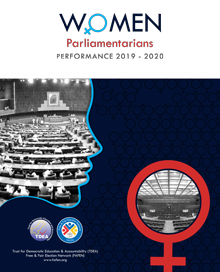- TDEA-FAFEN Releases Women Parliamentarians Performance Report on the Eve of International Women’s Day
ISLAMABAD, March 7, 2020: Women parliamentarians continued to be proactive and assertive in their legislative, representative and oversight functions during the past year. Despite being only one-fifth of the current parliament, women sponsored more than one-third of the business, effectively raising citizens’ voices and public interest issues, reveals a report released by the Trust for Democratic Education and Accountability- Free and Fair Election Network (TDEA-FAFEN) on the eve of International Women’s Day.
Between March 2019 and February 2020, almost all women members actively participated in parliamentary proceedings. Out of the 89 women parliamentarians — 69 Members of National Assembly and 20 Senators — 87 sponsored agenda and/or participated in parliamentary debates. On average, each woman legislator sponsored at least 16 agenda items, and spoke at least three times on the floors of the Senate, and the National Assembly. Apart from contributing to the overall parliamentary agenda, women parliamentarians also regularly attended sessions. On average, each woman parliamentarian attended 79 percent of the parliamentary sittings, while this ratio stood at 66 percent for men.
Despite their substantial interest and active participation in parliamentary business, women parliamentarians faced challenges in having their voices heard. Nearly a third of women-sponsored parliamentary agenda were not taken up during the proceedings. Similarly, the Chair only allowed women 16 percent of the total parliamentary time allocated to debates.
Women parliamentarians compete, collaborate with Men colleagues
Compared to their men counterparts, women parliamentarians sponsored almost double the number of parliamentary agenda, and also collaborated with them in sponsoring matters of public interest in parliament. Women along with men parliamentarians jointly sponsored half (51 percent) of the calling attention notices in the National Assembly. Thirteen percent amendments to the rules of procedure, nine percent private members’ bills, and seven percent resolutions were jointly coined by men and women in the Lower House. In the Senate, 20 percent motions for public importance debates, eight percent resolutions and two percent private members’ legislation was jointly sponsored by men and women.
Women Sponsored More Private Business
Most of the agenda sponsored by women, however, was in their private capacities. Whereas, government agenda in parliament continues to be men-dominated due to low representation of women in the executive. Men members of the cabinet accounted for 89 percent of government business, while women ministers initiated only 11 percent of government-agenda items. Women’s contribution to government business in the National Assembly was slightly higher (12 percent) than their contribution in the Senate (eight percent), presumably due to higher number of women Members of National Assembly (MNAs) among parliamentary secretaries. Among 36 parliamentary secretaries, there are 13 women.
NA ignores more women-sponsored agenda than the Senate
A third of the women-sponsored agenda — in both the National Assembly, and the Senate — did not yield any debate or vote. The percentage of women’s unaddressed agenda in the National Assembly (38 percent) was significantly higher than the percentage of women’s unaddressed agenda in the Senate (10 percent).
Compared to men-sponsored agenda, women-sponsored agenda did not get the same attention in the National Assembly. However, the Senate was more responsive to women-sponsored agenda in its proceedings. The National Assembly’s transaction rate — percentage of the agenda taken up during the proceedings — was 62 percent in case of women-sponsored agenda, and 67 percent in case of men-sponsored agenda. Whereas, the Senate’s transaction rate was 90 percent in case of women-sponsored agenda, and 89 percent in case of men-sponsored agenda.
Women MNAs sponsor more agenda, women Senators more active in debates
Women’s contribution to the National Assembly’s agenda is relatively greater than their contribution to the Senate’s agenda. Women MNAs sponsored 36 percent of the National Assembly agenda — 33 percent on their own and three percent in collaboration with their men colleagues. In the Senate, women brought a quarter of the parliamentary business — 22 percent on their own and three percent in collaboration with men. Women MNAs also outperformed their Senate counterparts in regularity. Women MNAs attended 80 percent of the sittings, while women Senators 75 percent.
However, women Senators remained more active during the house debates in comparison to women MNAs. Each woman MNA took part in the debates for an average of 11 minutes, whereas each woman Senator averaged 26 minutes.
Women MNAs’ agenda contribution declines, Senators’ increases
Women’s contribution to parliamentary business has varied over time. The contribution of women MNAs has dwindled from two-third to around one-third since 2009 when TDEA-FAFEN first launched its annual performance analysis. On the contrary, since 2015, women Senators’ contributions have surged from 18 to 25 percent.
For the complete report, click here


